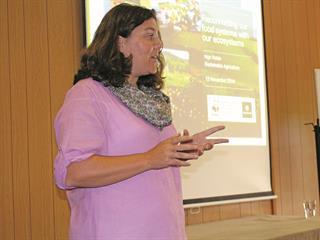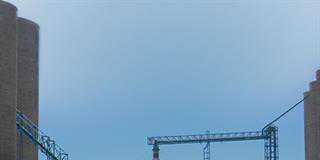
Agriculture propels global ecological change and drives deforestation, erosion, soil degradation and sedimentation – all of which have an impact on water runoff, storage and quality. This is according to Inge Kotze, manager of the World Wide Fund for Nature’s (WWF) sustainable agriculture programme.
Good agricultural land, available water and the energy required to farm form a nexus, she adds. “The world will need 70% more food by 2050 in order to feed an estimated global population of nine billion,” she explains. Moreover, there is paradoxical vulnerability across the food chain, with hunger and access problems prevalent in the poorest sectors, and resources pressurised by a growing middle class.
Christine Coleman, WWF freshwater ecologist stresses that water resources are not infinite. “A total of 98% of the available water in South Africa has already been allocated to users,” she explains. “South Africa has half the global average of rain at 490mm/annum, an evapotranspiration rate of 1 800mm/annum and a low conversion of rainfall to runoff (9%).
“With figures like this, we can’t focus on the tap-end of the water value chain.” Farmers need to manage for increased production per hectare, per kilolitre of water and per kilogram of agrichemical product. Because they depend heavily on soil and water, they must take management beyond their fences and into the catchments, or run the risk of resource loss.
Water-source areas, areas of higher agricultural value, biodiversity hotspots and mining often overlap, says Kotze, explaining that WWF is mandated to manage drivers so that biodiversity is maintained. “Farmers are a critical part of this, whether they are commercial or communal, upstream or downstream.”
She describes farmers as the custodians of catchment assets and says that agricultural land often contains headwater areas. Agriculture, she explains, is the key to the reconnection and rehabilitation of the landscape, and to the re-establishment of a healthy functional system.
“Many farmers are already working towards better production standards and using the tools provided to help meet risk and market requirements.”
FIRST STEPS
The following are regarded as essential to protecting water resources:
- Buffering water systems against loss
Water systems must be managed to buffer against drought, degraded soils, excessive runoff and fire risk. Part of this management is the removal of invasive alien plants, which drain water and create fire problems. “It’s estimated that 7% of national runoff is consumed by alien vegetation,” says Coleman. This figure is thought to be the equivalent of the water used in the eThekwini Metropolitan Municipality annually, and illustrates how important it is to get on top of the alien plant problem.
- Protecting and restoring wetlands
Managing wetlands and reversing the 70% loss of these areas due to production practices must be addressed.
Wetlands function to mitigate flooding and store water. They are natural filters and sediment traps; they provide grazing and release water during dry periods, and are an important part of the catchment.
“Let’s get the best possible production with what we have, and work towards efficient resource utilisation,” says Kotze.
- The value of water
Kotze says that farmers readily identify with input costs, profits and optimal use of resources. It is important that they be made to understand that natural areas are of value – upstream and downstream – in the water value chain.
Says Coleman: “Irrigated agriculture is South Africa’s biggest water consumer, using 60% of all water removed from natural systems. This is excluding water taken up by forestry and stock watering. The mining sector uses only 2,5%, but that is not the water footprint of mining.”
Agricultural consumption returns water into rivers or groundwater systems, while water used in mining is often not returned and it is polluted.
WHERE DOES WATER COME FROM?
Water comes from natural living landscapes, the architectural infrastructure of our ecology, explains Coleman. The quality, and often the quantity, of the water is better if the ecological infrastructure is healthy. This infrastructure includes wetlands, riparian systems and underground aquifers.
“Living landscapes are the initial source of water and that’s what we focus on,” she says. Dairy farming, piggeries, sugarcane farming and forestry have a major impact on the Umgeni catchment’s rural areas. However, informal settlements also cause problems in water quality, and affect surrounding communities.
The catchment should be seen as a complex whole. “We can’t really dig in and defend what we have with water, because it flows from one farm to the next – from one catchment to the next. This is why strategic partnerships have invested in the notion of water stewardship,” says Coleman.
Water stewardship is a process in which farmers become water-aware and learn to read the ‘water footprint’ of their industry. It is a concept that embraces collective action and an understanding of catchment processes. The Department of Water Affairs estimates that R700 billion will be needed to upgrade, maintain and build new engineered infrastructure in 10 years. However, there is no financial projection for the cost of maintaining the catchments and mitigating the agricultural effect on the water that runs into this expensive infrastructure.
WWF’s ‘water kit’
WWF has devised a tool – the water risk filter – for assessing business risk in various parts of a catchment. “If, for example, a farmer wished to buy land, he could check the risk status of that land in terms of physical water risk, regulator risk and the reputation risk of operating in a specific catchment,” Coleman explains.
This tool has translated a complicated picture of ecosystems and engineering into something understandable and usable.
“We must promote a paradigm change. We no longer face options of ‘environment or economy, greenies or agriculture’. The entire economy is embedded in the social system, which is embedded in the environment.”
Responsible water citizens
The Umgeni River has a 4 432km2 catchment area and a well-developed integrated catchment management. Water quality is a problem in this system, with purification costing the Durban municipality as much as R120 million in bad months. Fruit farmers in the Western Cape have an excellent record for water efficiency, producing the most ‘crops per drop’ at 33l for a peach, compared to the global average of 140l for a peach.
Communities have been provided with hippo rollers to provide temporary relief. These are water containers on rollers that make it easier to access and transport water. “We need interim measures to provide rural people with water at the lowest cost,” says Christine Coleman of the WWF.
In the Umgeni catchment, communities are empowered as ‘water citizens’ to take charge of their role in water management.
School children are involved in monitoring river health by looking for insects that are known bio-indicators like dragonflies, caddisflies and mayflies. Community members monitor treated effluent at discharge points and clear riparian litter.












